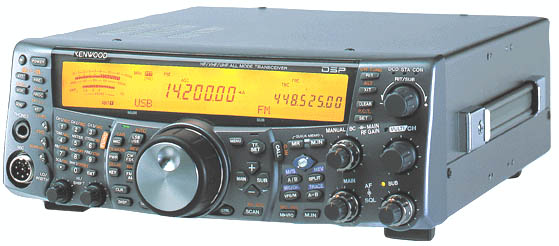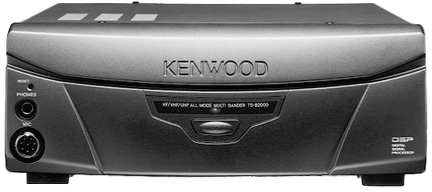TS-2000

|
\ãëàâíàÿ\ò.õ. ðàäèîñòàíöèé\... |
TS-2000
MAIN FEATURES
TS-B2000

*With optional RC-20001200MHz all-mode unit
IF Digital Signal Processing
The TS-2000/B2000 is serious about digital signal processing. Kenwood’s advanced digital technology converts analogue waveforms into digital data in real-time, enabling such digital processing as IF filtering, slope tune, auto notch and AGC. IF-stage DSP on main-band transmit and receive — including V/UHF bands — allows the greatest range of control and unprecedented performance.
IF-stage DSP means that the TS-2000/B2000 offers significantly lower distortion and higher quality detection in all modes. (FM: digital AF filter)
There is no need to purchase optional filters: digital IF filters are available for each mode (FM: digital AF filter), offering performance superior to anything possible with analogue circuitry. When operating in SSB/FM/AM modes, this digital filtering enables both high- and low-cut frequency variance. Employing slope tune, you can thus cut out noise with minimal effect on sound quality. In AM mode, the high-cut frequency can reduce interference by controlling the IF pass bandwidth — useful for receiving short-wave broadcasts. In CW mode, the WIDTH function is supplemented by centre frequency shift, allowing adjacent signal interference to be tuned out. This WIDTH function also provides noise reduction capabilities in FSK with 4 steps available: 250, 500, 1000 and 1500Hz. And thanks to AF-stage DSP, independent control of high-cut and low-cut frequencies (12 steps each) provides slope tune capability in FM as well.
Since it is working with a digital signal, IF Auto Notch (main band, SSB mode) can provide extremely sharp filtering of carrier frequencies from broadcast and continuous beat sources. The interfering beat is removed far more accurately than in conventional analogue systems, and Auto Notch will even track changes in the beat signal (tracking speed can be varied in 5 steps).
The digital AGC circuit (main band only) delivers very fast release characteristics, surpassing even the best analogue designs. You can select a custom release time (20 steps) for each mode, except FM.
AF Digital Signal Processing
DSP is also executed at the AF stage, offering Beat Cancel and CW Auto Tune functions. It also enables you to achieve remarkable noise reduction and apply custom enhancements to your transmitted voice.
Automatic Beat Cancel, available for the main band (SSB and AM modes), immediately eliminates multiple beats interfering with a desired signal. It works well in combination with IF Auto-Notch (SSB).
A new Manual Beat Cancel function, which operates as a manual AF notch, can be used in all modes — though it is particularly effective in CW.
You no longer have to adjust the VFO while operating on CW — CW Auto Tune does it for you automatically by adjusting the VFO to your preset pitch at the touch of a button.
There are 2 types of noise reduction: LEM (NR1) and SPAC (NR2). LEM (Line Enhancer Method) — available for all modes on the main band and FM/AM on the sub band — automatically forms a filter shape around the target signal for a custom, dynamic noise reduction capability. The degree of enhancement can also be set manually for main-band use. The SPAC (Speech Processing/Auto Correlation) function utilizes a special statistical/correlation algorithm to pull out weak signals that are buried deep in noise. Although available for all modes on the main band, it’s especially useful for tough CW conditions. The correlation time setting can be adjusted in 10 steps between 2ms and 20ms.
You have 3 ways to tailor audio quality with DSP: the TX/RX equalizer (SSB/FM/AM), TX filter bandwidth (SSB/AM), and speech processor (SSB/FM/AM). The TX/RX equalizer offers 4 frequency response settings on SSB, FM and AM: high boost for improved clarity, formant pass to minimize extraneous sounds, bass boost for stronger sound, and conventional mode for an ‘analogue’ sound. On SSB and AM transmit you can choose between 6 TX filter bandwidth settings according to your microphone and operating requirements. The speech processor works across three bands (SSB, FM and AM) for high compression and minimal distortion.
Expanded Power and Performance
The simple 2-chip TNC is compliant with the AX.25 protocol for DX cluster tune. DX cluster information received on the sub band is not just displayed on the LCD, it can also be used for instantly setting up the main band frequency to cluster information.
Up to 10 items can be stored in memory.
Provision of main and sub bands enables dual-channel watch. This all-mode multi-bander can simultaneously receive two frequencies, even on the same band, allowing such combinations as HF+V/UHF, VHF+VHF, UHF+UHF and VHF+UHF (the sub band is used exclusively for 144/430MHz reception on FM/AM). This means, for instance, that you can pick up local information on V/UHF while operating HF on the main band.
Satellite operations are enhanced with the IF DSP, 10 dedicated memory channels, Doppler effect frequency adjustment (manual) and the ability to choose either normal or reverse shift for the trace.
This transceiver is the perfect choice for contesting, mobiling and FSK applications, delivering up to 100 (AM: 25) watts on HF/50/144MHz bands. Output is 50 (AM: 12.5) watts on the 430MHz band, and 10 (AM: 2.5) watts on 1200MHz.* But there’s more than just power: the built-in TCXO ensures excellent frequency stability — ±0.5ppm (except in FM mode).
*Minimum output is 5 watts for HF/50/144/430MHz bands, 1 watt for 1200MHz .
In addition to the new Auto Tune function, there is a full range of CW features. The full/semi break-in switching and delay time settings are fully adjustable. In semi break-in the delay time between key release and active receive mode can be set for between 50ms and 1000ms. When using VOX operation the delay time can be set for between 150ms and 3000ms. Other CW features include pitch control (400-1000Hz), side tone monitor with 10-step volume setting, DSP-based rise time adjustment, and CW reverse mode.
When operating in FSK mode, you can select shift frequencies (170, 200, 425 and 850Hz) and switch both KEY polarity and Hi/Low tones to suit your RTTY device. Additionally, the FSK reverse function lets you match transmission methods to the other party if necessary, for example changing the BFO frequency from LSB (normal) to USB (reverse).
As well as switchable Narrow/Wide deviation modes, the TS-2000/B2000 has built-in CTCSS functionality with 38 EIA-standard sub-tones settings plus 1750Hz tone burst. Other features include DCS (104 codes) and 1200MHz ALT.
Packet filter bandwidth is fully selectable to match packet speed, and you can also switch ACC2 (PKD) input/output levels. For PSK31 mode, the menu offers a 100Hz bandwidth IF DSP filter.
Enhanced Operating Ease
The built-in antenna tuner — which also operates when the radio is in receive mode — covers amateur bands from 1.9 to 50MHz, with rapid tuning lock when using presets.
This transceiver provides a bank of 300 memories (plus 1 call channel for each band), with 290 assignable by name and 10 available for programmable scan. The scroll function lets you browse memory contents, memory channel copy sends the contents of one channel to another, lock-out memory changes the scan map to exclude certain channels, and memory shift alters the frequency stored in a channel. In addition, there are 10 ‘quick’ memories to capture a current operation on-the-fly — ideal for contest operation.
A full range of scan functions is provided, including MHz scan, memory scan, and call scan. Group scan mode covers all 300 memory channels in groups of 10, and programmable band scan will search a frequency spread between two VFO settings (the scan-hold function stops the scanning for 5 seconds). A new feature is programmable slow scan, which will automatically slow down to check a frequency range you’re interested in. As well as varying scan speed, you can choose either time-operated (TO) or carrier-operated (CO) busy-stop-resume.
All of the power and functions of the TS-2000/B2000 can be accessed through the menu-driven display interface on the front panel. You may also activate the Quick Menu feature to access only your most commonly used functions.
Other Features
Options
*The UT-20 can only be installed by a qualified technician; do not attempt to install it yourself.
** Do not install the MB-430 Mobile Bracket vertically as this would adversely affect transceiver operation and safety.
Not all accessories may be available, please contact dealers for details.
Specifications
|
TS-2000/TS-B2000 |
|
|
GENERAL |
|
|
Transmitter Frequency Range |
Main: 160, 80, 40, 30, 20, 17, 15, 12, 10, 6, 2 meter bands, 70, 23* cm bands Sub: 2 meter band, 70cm band |
|
Receiver Frequency Range |
Main: (0.03) 0.5 ~ 30 MHz, Sub: 144 ~ 146 MHz, 430 ~440 MHz Figures in parenthesis ( ) indicate VFO coverage range |
|
Mode |
A1A (CW), J3E (SSB), A3E (AM), F3E (FM), |
|
Power Requirement |
13.8 V DC ±15% |
|
Current Drain (Less than) |
Transmit: 20.5 A (HF, 6m, 2m), |
|
Operating Temperature |
-10° C ~ +50° C |
|
Frequency Stability |
Main: Other mode within ±10 x 10-6 Sub: Within ±10 x 10-6 ±600 Hz |
|
Antenna Impedance |
50 |
|
Microphone Impedance |
600 |
|
Dimensions, projections not included (W x H x D) |
|
|
Weight (approx.) |
TS-2000: 7.8 kg |
|
TRANSMITTER |
|
|
RF Output Power |
SSB/CW/FM/FSK=100W, SSB/CW/FM/FSK=50W, AM=12.5W (70cm) SSB/CW/FM/FSK=10W, AM=2.5W (23cm)* |
|
Modulation |
Reactance modulation Low-level modulation |
|
Maximum Frequency Deviation (FM) |
Less than ±5 kHz (wide) |
|
Spurious Radiation |
1.8 ~ 28MHz: Less than –50dB 50 ~ 430MHz: Less than –60dB 1200MHz*: Less than –50dB |
|
Carrier Suppression |
More than 50 dB |
|
Unwanted Sideband Suppression |
More than 50 dB |
|
Transmit Frequency Response |
|
|
XIT Variable Range |
±20.00 kHz |
|
Antenna Tunable Range |
16.7 |
|
RECEIVER |
|
|
Circuitry |
Triple conversion superheterodyne |
|
Intermediate Frequency
|
41.895 MHz (144/430MHz), 135.495 MHz (1200MHz)* 10.695 MHz 455 kHz 12.0 kHz 58.525 MHz 455 kHz |
|
Sensitivity AM (S/N 10 dB) FM (12 dB SINAD) Sub: AM (S/N 10 dB) FM (12 dB SINAD) |
Less than 0.2 µV (1.705 ~ 24.5 MHz), Less than 0.13 µV (24.5 ~ 30 MHz), Less than 0.13 µV (50 ~ 54 MHz), Less than 0.11 µV (144 ~ 146 MHz), Less than 0.11 µV (430 ~ 440 MHz), Less than 0.11 µV (1240 ~ 1300MHz)* Less than 31.6 µV (500 kHz ~ 1.705 MHz), Less than 0.22 µV (28 ~ 30 MHz), Less than 1.55 µV (144 ~ 146 MHz), Less than 0.28 µV (144 ~ 146 MHz) |
|
Squelch Sensitivity
Sub: AM FM |
Less than 1.8 µV (1.8 ~ 28.7 MHz), Less than 1.1 µV (50 ~ 54 MHz), Less than 1.1 µV (144 ~ 146 MHz), Less than 1.1 µV (430 ~ 440 MHz), Less than 1.1 µV (1240 ~ 1300MHz)* Less than 0.2 µV (28 ~ 30 MHz), Less than 1.1 µV (144 ~ 146 MHz), Less than 0.18 µV (144 ~ 146 MHz), |
|
Image Rejection Ratio |
|
|
IF Rejection Ratio |
|
|
Selectivity Hi:3000MHz) FM FM (Narrow) Sub: AM FM |
Less than 4.4 kHz (-60 dB) More than 6.0 kHz (-6 dB), More than 12.0 kHz (-6 dB), More than 8.0 kHz (-6 dB), More than 12.0 kHz (-6 dB), More than 12.0 kHz (-6 dB), |
|
RIT Variable Range |
±20.00 kHz |
|
Notch Filter Reduction |
More than 30 dB (1 kHz) |
|
Beat Elimination |
More than 40 dB (1 kHz) |
|
Low Frequency Output |
More than 1.5 W 8W at 10% distortion |
*With optional UT-20 1200MHz all-mode unit.
Kenwood follows a policy of continuous advancement in development.
For this reason specifications may be changed without notice.These specifications are guaranteed for Amateur Bands only.